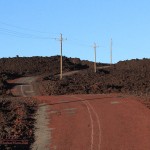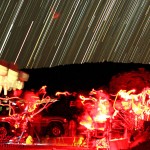I was determined to get out and use the telescope during the March new Moon, but had planned to go observing with the guys at Hale Pohaku on Mauna Kea. At the last minute I decided to accept an invitation from the Hilo group to observe from Mauna Loa instead. The guys planned on running a Messier Marathon, something I have enjoyed many times before.
Our usual observing location is Hale Pohaku, at 9,000ft on the south side of Mauna Kea. Hale Pohaku is a great observing site, high enough to be above the clouds, but well below the summit where thin air, wind and frigid temperatures can be miserable. It is impossible to do a complete Messier Marathon from Hale Pohaku, the bulk of Mauna Kea blocks too much of the northern sky making a few objects, most notably M52, difficult to impossible.

The night was pretty good, featuring very good transparency and a clear, dark sky. The seeing was marginal, hoped for views of Mars near opposition and Saturn were soft. The only real problem was a stiff wind sweeping down the mountain from the snow covered summit. The biting cold was promising to be an issue, one we fortunately moderated through careful selection of a setup site.
Several members of the night’s star party work at the facilities on Mauna Loa. Thus we were able to open the gate and set up near the research station. Just before the station is a small borrow pit, a spot where machinery dug into the mountainside. There was room to park several vehicles and set up several telescopes against a 15 foot embankment. The shelter offered by the little gravel pit moderated the wind to merely annoying in place of miserable.

I had two telescopes along, but never set up the 18″ in the wind. Instead I used my 6″RFT for the night. The telescope is a marathon veteran, having chased these objects many times before, including a perfect score in 2001 at the All Arizona Messier Marathon.
We all achieved perfect evening scores, hitting M52 first, having little trouble with the M31 group, M77 was easy, I had a bit of a struggle with M74 in the bright glow of zodiacal light. All of us are skilled observers with many years experience, it showed as we nailed many of the objects from memory. None of the telescopes in use provided computers, Josh had setting circles on his Losmandy mount but I never saw him use them, or even polar align the ‘scope. This was a marathon run on purist rules. Nothing but finder ‘scopes and charts to locate each object.
The rest of the evening was spent working our way across the sky, with more time to enjoy the sights in the telescope as we used a two century old observing list. As usual the list is pretty easy until you arrive in the Virgo Cluster. Here the swarming galaxies offer a midnight challenge for any observer. My little 6″ is perfect for this area, a wide field that allows me to hop from galaxy to galaxy, and a smaller aperture that picks up the brighter messier objects without too much clutter from the numerous fainter objects.
After Virgo one must wait for more objects to rise to complete the list. Nebula Row in Sagittarius is a pleasant section of the sky to work through, with rich starfields so well suited to a rich field telelscope. M24 was particularly worth noting. The star cloud is too large for higher magnification instruments, while perfect for a wide field ‘scope. The field was studded with clusters and dark nebulae, worth a moment to pause and admire before continuing the list.
The challenge of the morning was M73 and M73, not because of the light of dawn, but because of the Moon. A 15% crescent was sitting betwixt the pair! The usual challenge of a Messier Marathon, M30, was downright easy. We struggled with the asterism and the globular.
In the end we all managed to score 109’s. With a split on seeing either M72 or M73. Josh and I managed to detect 73 with our smaller apertures. It was tough, averted vision and rocking the ‘scope was necessary to pick out a small hazy patch. I repeated the experiment a couple times more to be certain. Mike used his 20″ to find this asterism of four stars, but could not see the globular. Quite a feat when you realize that the group was a mere 15 arc-minutes from the illuminated limb of the Moon.
Without the Moon complicating M73 and M73 all three of us would have managed perfect scores. The site is nearly perfect, the latitude is an advantage, and all three observers have the skill needed. I wonder if I should try again from Mauna Loa next Messier Marathon season.

